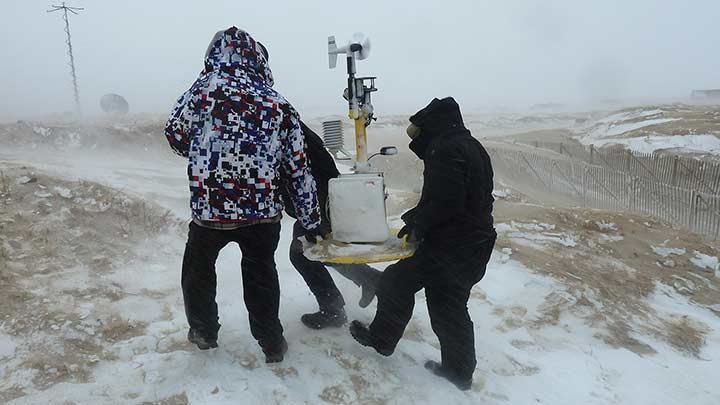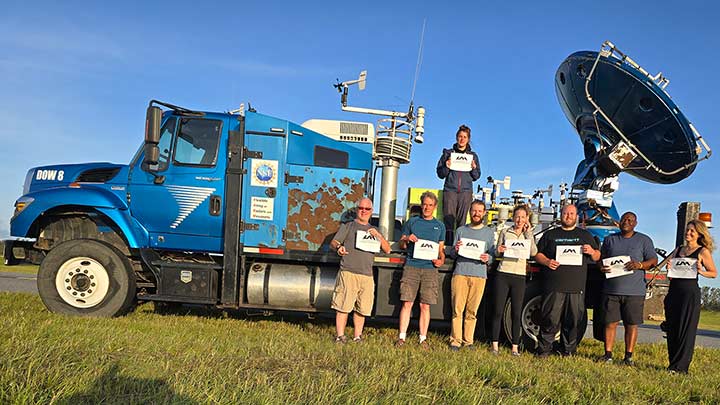With the addition of the Flexible Array of Radars and Mesonets (FARM) team to its deployable weather research fleet, the Severe Weather Institute – Radar and Lightning Laboratories (SWIRLL) at The University of Alabama in Huntsville (UAH) will be the largest and most comprehensive mobile radar and observing facility in the U.S. UAH is part of The University of Alabama System.

Dr. Karen Kosiba (left) and Dr. Josh Wurman (right) inside DOW.
Courtesy: The FARM
“The addition of the FARM facility to the existing MAPNet facility marks a monumental milestone for UAH, establishing it as the largest and most comprehensive mobile radar, profiler, and observing facility in the United States," said Dr. Kevin Knupp, principal research scientist in the UAH Earth System Science Center (ESSC). “This addition makes UAH a clear leader in meteorological field research.”
The UAH SWIRLL facility is an essential resource for educational initiatives, student research, and extensive weather projects. Its strategic location in the Southeast allows it to serve as a central hub for weather-related experiments, significantly enhancing data collection and research capabilities.
With the integration of the FARM systems, which will be based in Boulder, Colorado, SWIRLL’s operations are expanding regular operations into the Great Plains and Midwest. This expansion will further strengthen its role in advancing meteorological research across broader regions.
Meet the FARM team
UAH’s new SWIRLL Great Plains team consists of seven full-time employees and two part-time workers with decades of experience. Leading the FARM initiative are Dr. Josh Wurman and Dr. Karen Kosiba, prominent scientists with extensive experience in severe weather research and radar technology innovation. Their system includes the Doppler on Wheels (DOW) radars, mobile mesonets, upper-air sounding systems, disdrometers, and deployable instrumented pods, offering unprecedented scientific research and hands-on student involvement opportunities.

Dr. Josh Wurman and the DOW in Washington during a flooding event.
Courtesy: The FARM
Dr. Wurman is widely known for pioneering mobile radar technology and spearheading ambitious storm observation missions globally, using mobile radar systems to study tornadoes and hurricanes up close. His work has been featured on platforms like National Geographic, History Channel, and Discovery Channel’s Storm Chasers, showcasing the adventure of extreme weather science. "We're out there discovering new things. We're seeing things that nobody has ever seen before," he explained, highlighting the impact of these technological advancements on understanding severe weather patterns and improving forecasting models.

The FARM team deploying instrumentation to collect data during a Nor’easter.
Courtesy: The FARM
Dr. Kosiba, with a background in physics, has spent the last 20 years immersed in severe weather research, driven by her passion for tornadoes, hurricanes, and cutting-edge observational technologies. Her love for fieldwork and collecting high-quality data in challenging environments, such as alpine regions and storm-prone areas, has defined her career. She has contributed to numerous projects involving snow, alpine weather, and severe storms. Kosiba’s expertise in deploying advanced radar systems and innovative instrumentation has been vital in filling critical gaps in storm research. She focuses on the importance of involving students in various research projects, from boundary layer studies to hurricane observation, to provide hands-on experience and equip them with the skills needed for careers in atmospheric science.
'With the world-class expertise of Drs. Wurman and Kosiba along with UAH’s considerable infrastructure and scientists, UAH is set to be a leader in the next generation of high-impact weather research," says Dr. John Christy, Director of the UAH’s ESSC.
The Future with FARM
The FARM radars have mapped out ultra-fine scale details in 250 tornadoes and 18 landfalling hurricanes, making discoveries about how these storms cause damage and evolve. Beyond extreme weather events, the FARM system has been deployed in dozens of other projects, including winter precipitation, icing, blizzards, lake effect storms, alpine meteorology, weather modification, agricultural meteorology, aviation meteorology, wildfires, and hydrological studies.

The FARM team.
Courtesy: The FARM
They have taken the DOW radars around the globe, from Argentina and Europe to Alaska and Hawaii and nearly every state in the continental US. Each environment presents unique scientific puzzles, and they are eager to see how they can contribute at UAH. During the spring of 2025, the FARM will deploy four mobile radars and other instruments to the Great Plains for the largest-ever hail study.
Looking ahead, the new team is enthusiastic to involve students in their projects, offering fieldwork and educational engagement opportunities. Integrating the FARM into UAH represents a transformative development, elevating the SWIRLL facility to the forefront of mobile weather observation.